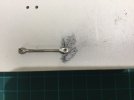Might be closer to getting the chassis in the jig after a few more hours done. Where does the time go!
So the dilemma was 2 coupling rods with oval holes soldered in with brass tube, no knowing if the 4 x bits of brass tube in anyway lined up. The ovals originally filed out to get the chassis to run were pretty generous!
The crankpin brass bearings for want of a better word are 1.5mm OD so the new reamers were set to work as you helpful chaps advised.
View attachment 234598
View attachment 234601
View attachment 234604
View attachment 234603
Working from both sides works, so you can keep a good 90 deg to the piece.
I didn’t have a 1.5mm in my set closest was 1.6mm I accidentally went all the way down. Ah! I rolled with it making sure the other end and one on the next rod were 1.5mm by using the vernier and marking the shank with marker pen.
Then the fun and games trying to judge a centre on the last end to make a matched pair!
By eye I drilled a 1mm hole central as I could.
View attachment 234588
Then using a 2.3mm reamer which fitted the hole I scribed an arc!
View attachment 234589
umm off centre. But then I realised the brass insert I filed up In the drill was not perfect in the hole, so I superglued that in and repeated the proces.
View attachment 234590
View attachment 234593View attachment 234594View attachment 234592
That looked like luck was on my side so in with the reamer on the last hole.
Sat them on the jig then found Id lost a crankpin bearing in the intervening years to now!
I had 6 think I destroyed 2 filing them down . See if I can find one or make another!
View attachment 234596
View attachment 234595
Thanks for your likes and interest.
More soon.




















